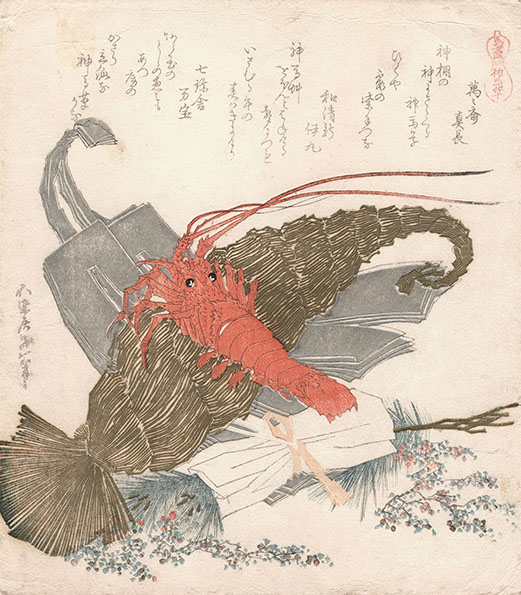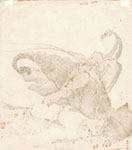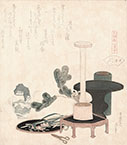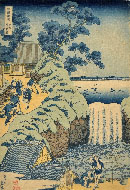(1760 - 1849)
CRAYFISH WITH NEW YEAR DECORATIONS, 1822
Colour woodblock print, shikishiban surimono from the series A Selection of Horses (Umazukushi), 1822. Signed Fusenkyo Iitsu hitsu. Three poems by Mamansai Managa, Shicchinsha Manpo and an associate.
Fine impression with metallic powders (silver and gold) very well retained. See here a detail of the golden powder. Very good colour, minimal defects, generally in very good condition 205 x 180 mm.
PROVENANCE: on the verso three unidentified collector’s mark stamped in red.
The print was sold in Paris c/o Hotel Drouot Rive Gauche, on the days 12, 13, 14 and 15 December 1977, Commissaires-Priseurs Boisgirard & de Heeckeren, Collection de Monsieur… Estampes, Designs, Pochoirs du Japan; lot 278. In that catalogue the print was declared as coming from the Charles Haviland sale, c. 1922.
Private collection, Milan.
Two other impressions of this rare surimono are preserved at the British Museum (1907,0531,0.152) and at the Harvard Art Museum (1933.4.1792). Another one was published in the catalogue of the Scheiwe collection in 1972; see Rose Hempel, Ukiyo-e, Die Kunst der heiter vergänglichen Welt, Japan 17.-19. Jahrhundert, Essen, 1972; n. 296.
Compared with these other specimens, our impression seems in the best condition, at least regarding the preservation of the silver powder. It is also interesting to note that the position of the poems in our specimen is slightly different: they are printed from the same block but moved down and to the right.
The series Umazukushi is composed of 27 single-sheet surimono and one triptych, all with subjects alluding to horses, designed by Hokusai for the horse year Bunsei 5 (1822). Most of the prints in this set are still-lives, and each of them refers to horses, although some of these allusions are very obscure. The set was designed for three poetry circles: the Yomogawa and two subgroups of it, the Shuchodo shachu and the Manjiren.
A very interesting presentation of this set and of the other set of square surimono designed by Hokusai for the same poetry circles, the series Genroku Kasen kaiawase, 1821, is found, in Italian, in the catalogue of the 1999 Milanese exhibition devoted to Hokusai. See Asano Shugo, Arte e circoli letterari di surimono: le serie Genroku Kasen kaiawase e Umazukushi; in G. Calza, Hokusai. Il vecchio pazzo per la pittura, Milan, 1999.
Hokusai was the greatest of all the Japanese painters of Ukiyo-e. He was a voracious student of a huge range of artistic techniques and his work covered a spectrum of art forms: polychrome or ink paintings; surimono (de luxe, small-edition woodblock prints) and polychrome prints; woodblocks for all kind of illustrated books; erotic pictures. Hokusai is thought to have made in all at least 30,000 drawings and the illustrations for 500 books. He led a life of singular variety, sustained by his inexhaustible energy.




